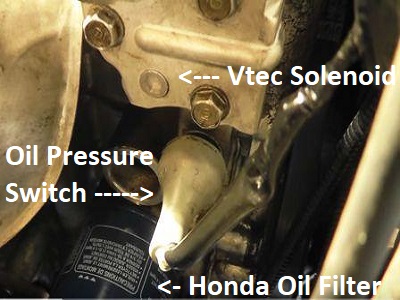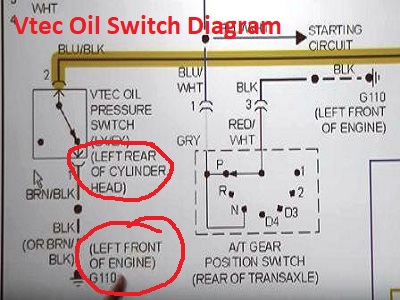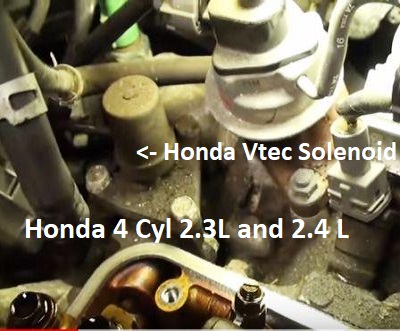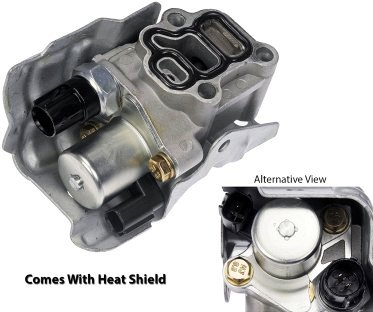Honda VTEC System Problems
When you experience Honda VTEC system problems it will often set a diagnostic trouble code to help point you in the direction of failed components. However, I just got done working on a 2002 Honda Accord with the four-cylinder engine.
In addition to the check engine light, the customer complained of, lack of power and bucking before shifting gears.
On a road test I found that the vehicle didn't want to go over 3000 RPMs. In this particular automobile, we traced the failure down to a defective valve timing oil pressure switch.
This little device threads into the Honda VTEC solenoid assembly. Upon further inspection, we found a small oil leak coming from the bottom corner of the solenoid housing.
Quick Links: Brand New Honda Vtec Solenoid Assembly with Pressure Switch.
For this reason we decided to pull the assembly off of the Honda Accord and take a look at it on the bench. What we found was a deteriorating gasket.
In this situation, I laid the repair options out for the driver. Obviously, replacing the gasket and the VTEC pressure switch would be the lowest cost option.
Then we called the dealership to price these two parts. When the driver decided to go online and shop around they found a complete assembly for less than the cost of the gasket from the local Honda dealership.
 Honda VTEC System Problems Diagram
Honda VTEC System Problems DiagramIn this article we'll talk about the signs and symptoms of Honda VTEC system problems.
We're also going to explain the major difference between the variable valve timing systems of a Honda automobile when compared to VVT problems with General Motors cars. Before we move on let's finish up the story about this 2002 Honda Accord.
When the customer drove over to the local Honda dealership, he talked to the service department about what the repairs would cost through the dealership. Of course, the service writer wanted to verify the failure before quoting prices.
However, with a little persuasion they told my customer parts and labor comes in around $400 for this repair. We got the parts for $60 and it took me about a half hour to put them in.
In this article we'll cover some repair tips and talk about the best way to access these components. Hint, you don't want to go in from the top and you probably want to pull off the wheel to gain access on a CRV.
Symptoms of Honda VTEC Problems
The general or most common Honda VTEC system problems produce symptoms that fall into two major categories.
The first one is a failure of the system to engage the high lift, longer duration lobe of the camshaft. We'll get into how the VTEC system works at the end of this article.
For now what we need to understand is the VTEC function is requested by the vehicles main computer. Long story short, the computer energizes the VTEC solenoid and the spool valve.
There are a couple of different codes that set depending on the defect in the system. With that said, the P1259 trouble code is the one I see most often.
This trouble code often leads to parts replacement, but still needs diagnosis to determine which one. We'll talk more about this in the diagnostic section below.
 Honda Vtec System Testing Diagram
Honda Vtec System Testing DiagramThere is an additional problem that Civic SI, CRV and Honda Accord owners probably wouldn't expect to find on their reliable Honda.
Another common symptom of Honda VTEC system problems becomes an oil leak that develops slowly, but consistently worsens over time.
The VTEC solenoid actually allows oil to flow to the internal galleries of the overhead camshaft. This means that the housing of the solenoid is holding back full engine oil pressure.
Unfortunately, the generous rubber gasket installed from the factory isn’t aging as well as Honda engineers hoped. In fact, the rubber starts to harden and shrink.
When this occurs we start to get a small oil leak. As the deterioration continues, we can even develop cracks in the factory rubber gasket. Then the oil escapes quickly from the engine at this point.
Diagnosing Honda VTEC System Problems
Let's start off with the common Honda check engine light code mentioned in the previous section. The P1259 stands for a VTEC system malfunction.
This doesn't exactly tell you what's wrong, but we already have a good idea of where to start. The oil pressure switch and the solenoid work together by activating the high performance setting on the camshaft.
As you can imagine the first thing you need to have is adequate engine oil pressure. On Hondas with high mileage this can be an issue. Sludge in the bottom of the oil pan from lack of maintenance can restrict the oil pump pickup screen and reduce engine oil pressure.
You can verify 30 psi of oil pressure at idle when the engine is hot using a mechanical gauge. Next the computer starts looking for the oil pressure switch to close to verify enough oil pressure exists to engage the camshaft into high performance mode.
Therefore, failure of the VTEC oil pressure switch causes the system to stand down and drivers complain about lack of power.
Although the Honda VTEC solenoid remains a reliable component it will not last forever. In my experience I have found the gasket around the housing to fail before the solenoid.
With that said, anytime I have just replaced the gasket I wound up replacing the solenoid at some near future date.
Therefore, I recommend if you have a failure of the oil switch that you should probably go ahead and replace the entire assembly if you plan on keeping the car for a while.
Finally, keep in mind that the oil pressure switch has two wires going to it and the signal wire to the solenoid is one power wire with a case ground. Damage to any of the wiring remains a strong possibility.
This is why I recommend using a automotive scan tool with data stream capabilities for diagnosing Honda VTEC system problems.
Not only will you be able to pull the trouble code that puts you on the correct path of diagnosis, but you can also pull up the data stream to verify wire integrity and proper operation.
How to Replace the VTEC Solenoid
 Honda Vtec Solenoid Location Diagram
Honda Vtec Solenoid Location DiagramThe difficulty level of replacing the Honda VTEC solenoid varies with the different models that use this technology.
The CRV provides more challenges, but also provides another access point when you remove the right front tire. Of course, you must show vigilance about safety by using Jack stands and wheel chocks.
You can hunt down your exact replacement procedure by searching for Honda Vtec solenoid replacement on YouTube.
On the Honda Civic SI and the accord with the 2.3 L or 2.4 L four-cylinder Honda engines we find the VTEC solenoid on the left rear of the cylinder head. The VTEC solenoid housing also provides a threaded hole for the oil pressure switch and o-ring we speak of in the diagnosis section above.
When you begin repairs you'll find three 10 mm retaining bolts. Getting at these with a wrench or 3/8 inch standard socket set is almost impossible.
However, a small sized quarter inch ratchet set with a small extension makes quick work of the repairs. On most models I can get this done in about 20 minutes. With that said, the first time I did it on a CRV I probably spent about an hour replacing the Honda VTEC solenoid assembly.
How the VTEC Solenoid System Works
 VTec Solenoid and Spool Valve
VTec Solenoid and Spool ValveThe Honda VTEC system is just the Honda way of performing variable valve timing. All of the major car companies are using (VVT) variable valve timing to increase performance and fuel economy at the same time.
The main advantage of the system comes from the ability to advance the timing on the fly when extra power becomes necessary.
Before we dig into how the Honda system works I wanted to mention that everybody is having problems with VVT technology.
Chevrolet uses cam phasers and actuators to advance the ignition timing. This allows them to make micro adjustments on the fly. Unfortunately, General Motors is having problems with VVT actuator solenoids.
General Motors uses the cam gear to adjust the ignition timing. Honda has taken a completely different approach.
They have a high performance lobe on the camshaft that increases the lift and duration. Basically, this means that the intake valve opens wider and stays open longer to increase the fuel charge for the combustion cycle.
We use to put high lift camshaft's in our muscle car engines, but they would run very poorly at idle. This made us compromise on just how radical we could go with a camshaft lift and duration.
Honda has solved this, because when the engine returns to idle they disengaged the high performance lobe using the VTEC solenoid to disengage that rocker arm.
Honda builds a good car. With that said, this VTEC problem will need addressing by thousands of drivers. However, it would seem worthwhile to make the repairs and continuing to operate the vehicle until bigger problems come along.
This is one of the reasons I recommend the Honda line of cars as a excellent entry-level vehicle. Stop by the fix my old ride website homepage to find out what else we cover on this automotive website specializing in older cars used for daily transportation.
Author bio : Mark is a retired ASE certified master technician, Chevrolet Professional Service Council member and the founder of FixMyOldRide.com. Watch the video on the about Mark the mechanic page to see his credentials. Mark hand writes all of the articles on FixMyOldRide.com unless indicated otherwise.